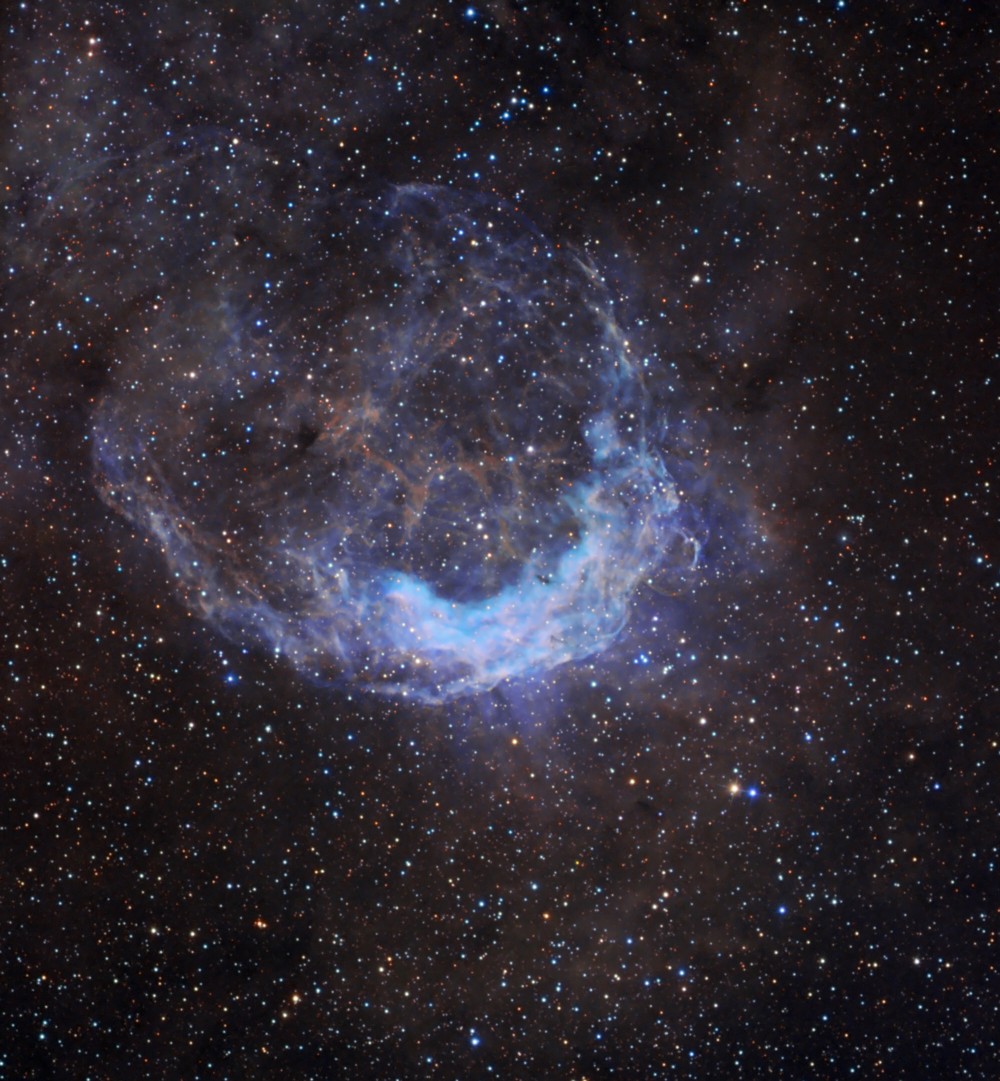One thing is certain, Wolf-Rayet stars produce some interesting science. In this week's portrait we see a distorted bubble produced by a moving star blowing a strong stellar wind into a surrounding uniform interstellar medium - yet is isn't uniform. What exactly is going on here?
Hanging out some 11,736 light years away in the southern constellation of Carina (RA 10:17:24.0 Dec -57:55:18), NGC 3199 is classed as a diffuse nebula or supernova remnant. Discovered by John Herschel in 1834, it has been known throughout historic astronomy observations as bright, large, crescent-shaped nebula with embedded stars, but modern astronomy shows it as much more. It's being pushed along by Wolf-Rayet star 18.
Says Dr. Michael Corcoran: "Wolf-Rayet stars (named for their discoverers) are very large,
massive stars
(stars which are about 20 times bigger than the sun) nearly at the end of their stellar lives. As these stars age, material which the stars have cooked up in their central nuclear furnaces (like carbon and oxygen) gradually reach the surface of the star. When enough material reaches the surface, it absorbs so much of the intense light from the star that an enormously strong wind starts to blow from the star's surface. This wind becomes so thick that it totally obscures the star - so when we look at a Wolf-Rayet star, we're really just seeing this thick wind. The amount of material which the wind carries away is very large - typically, a mass equivalent to that of the entire earth is lost from the star each year. The mass loss is so large that it significantly shortens the star's life, and as you can imagine has important effects on the space surrounding the star too. We think that very massive stars become
Wolf-Rayet stars
just before they explode as supernova (though no one has yet seen such a star explode).
At magnitude 11, NGC 3199 is observable with larger amateur telescopes, but the crescent shape is cause for study by some of the finest research telescopes and astronomers in the world. Through optical observations, the ring nebula and cavities around
WF stars
have painted a history of mass loss in these highly evolved stellar curiosities. By studying molecular gases associated with
Wolf-Rayet stars
, it appears that some materials seem to be avoiding optical emission.
In reading scientific reports submitted by A. P. Marston, molecular gas has already been observed around Wolf-Rayet Star 18 - the first to confirm the presence of HCN, HCO+, CN, and HNC and molecules. This makes the Wolf-Rayet ring nebula NGC 3199 very unique and filled associated molecular gas that took the form clumpy ejecta and interstellar material. At one time, NGC 3199's formation was believed to be caused by
bow shock
, but current data now shows the associated
Wolf Rayet star
is moving at a right angle to its enveloping environment. Could this be an indication that something else is at work here? Astronomers seem to think so.
According to their information, it is possible the northern area of the optically bright nebula is being torn apart by a possible blowout of Wolf Rayet wind. This, in turn, affects the surrounding ejecta and could very well account for the observed velocity. By modeling molecular abundances, the central
Wolf Rayet star
could be contributing a portion of its material to this nebula as ejecta. Despite its still unsolved mysteries, NGC 3199 is a stunning portrait. J.E. Dyson and Ghanbari summed it up best when they described it as an "interstellar snow plough".
This week's awesome astronomy picture is the work of Ken Crawford, taken at Macedon Ranges Observatory.
Says Ken: "This image was taken using an Apogee CCD Camera that uses primarily Narrow Band data which is color mapped mixed with RGB for natural star colors and back ground balancing. The bright blue area shows lots of OIII (ionized oxygen) signal which really shows the direction of the star movement well. The star is said to be moving at about 60 km/s through the interstellar gas."
 Universe Today
Universe Today
